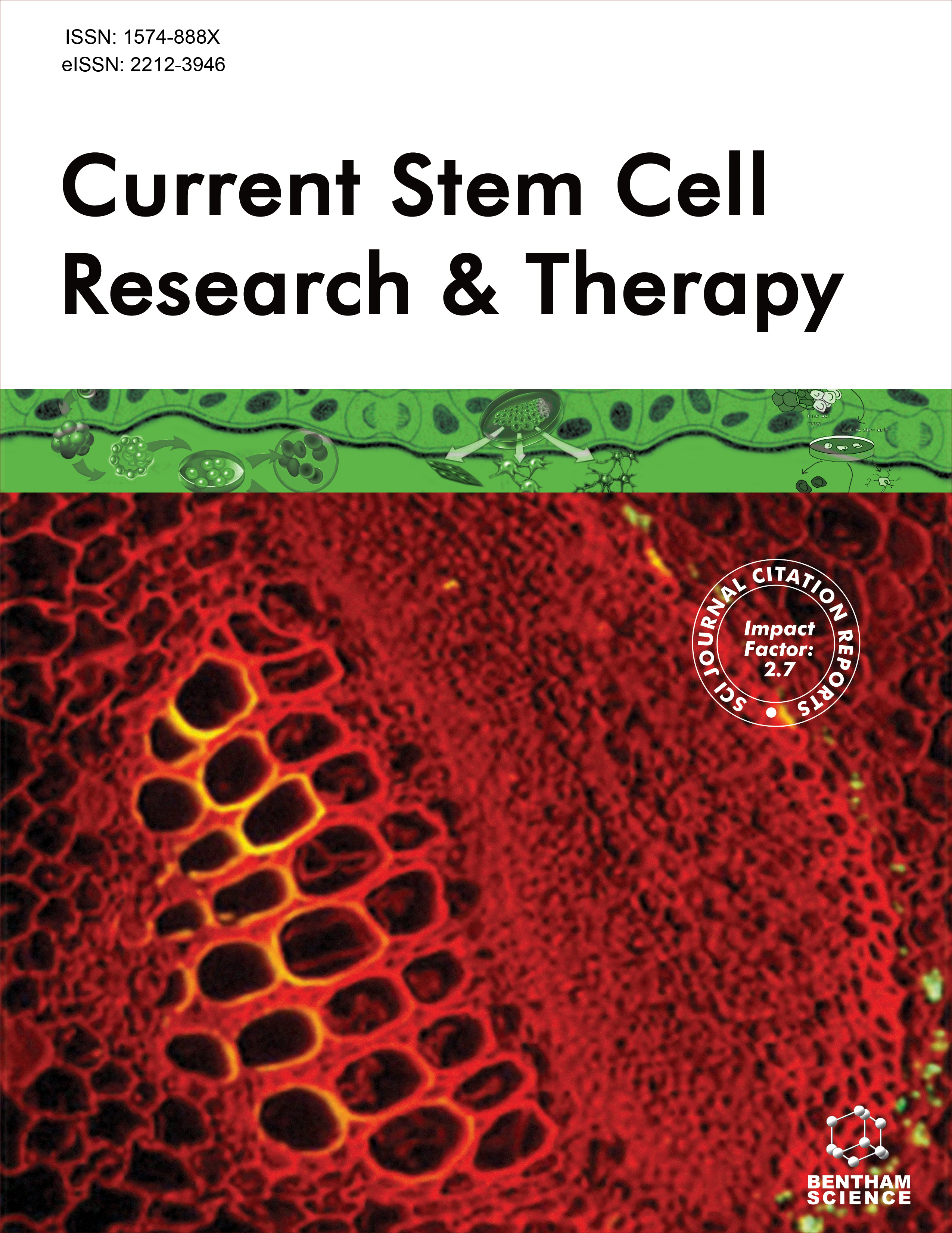- Home
- A-Z Publications
- Current Stem Cell Research & Therapy
- Previous Issues
- Volume 2, Issue 3, 2007
Current Stem Cell Research & Therapy - Volume 2, Issue 3, 2007
Volume 2, Issue 3, 2007
-
-
Is There a Clinical Future for Spermatogonial Stem Cells?
More LessAuthors: Goossens Ellen and Tournaye HermanLike every other adult stem cell in the human body, spermatogonial stem cells (SSCs) have the capacity to either renew themselves or to start the differentiation process, namely, spermatogenesis. Due to the continuation of the stem cell population in the testis, several possible options for preservation and reestablishment of the reproductive potential exist. Currently, spermatogonial stem cell transplantation (SSCT) is consi Read More
-
-
-
Deriving Respiratory Cell Types from Stem Cells
More LessAuthors: Fredrik Olsson, Mark Denham, Timothy J. Cole, Stuart B. Hooper and Richard MollardThe reported pluripotential capabilities of many human stem cell types has made them an attractive area of research, given the belief they may hold considerable therapeutic potential for treating a wide range of human diseases and injuries. Although the bulk of stem cell based research has focused on developing procedures for the treatment of pancreatic, neural, cardiovascular and haematopoietic diseases, the potential fo Read More
-
-
-
The Response of Human Mesenchymal Stem Cells to Osteogenic Signals and its Impact on Bone Tissue Engineering
More LessAuthors: Ramakrishnaiah Siddappa, Hugo Fernandes, Jun Liu, Clemens v. Blitterswijk and Jan de BoerBone tissue engineering using human mesenchymal stem cells (hMSCs) is a multidisciplinary field that aims to treat patients with trauma, spinal fusion and large bone defects. Cell-based bone tissue engineering encompasses the isolation of multipotent hMSCs from the bone marrow of the patient, in vitro expansion and seeding onto porous scaffold materials. In vitro pre-differentiation of hMSCs into the osteogenic lineage a Read More
-
-
-
CD34+ Fibrocytes: Morphology, Histogenesis and Function
More LessAuthors: Peter J. Barth and Christina C. WesthoffThe connective tissue of virtually all human organs harbors huge amounts of resident CD34+ fibrocytes. Recent studies have shown that CD34+ fibrocytes derive from circulating CD14+ monocytes. CD34+ fibrocytes are involved in wound healing, act as antigen presenting cells and secrete a multitude of cytokines. Due to their diverse functions CD34+ fibrocytes play a role in connective tissue diseases, pulmonary fibrosis and Read More
-
-
-
Potential for Clinical Ex Vivo Expansion of Cord Blood Haemopoietic Stem Cells Using Non-Haemopoietic Factor Supplements
More LessAuthors: Jonathon F. Hutton, Richard J. D'Andrea and Ian D. LewisThe establishment of culture systems that promote haemopoietic stem cell (HSC) self-renewal and expansion ex vivo will increase the clinical potential of umbilical cord blood (CB) HSC transplantation. Studies defining key signalling pathways that regulate development and expansion of HSC in vivo have greatly facilitated development of protocols for expanding HSC in ex vivo culture. Recently a number of soluble factors Read More
-
-
-
Use of Radioimmunotherapy in Stem Cell Transplantation and Posttransplantation: Focus on Yttrium 90 Ibritumomab Tiuxetan
More LessAuthors: Arturo Molina, Amrita Krishnan, Henry Fung, Ian W. Flinn, David Inwards, Jane N. Winter and Auayporn NademaneeAlthough autologous stem cell transplantation (ASCT) produces prolonged disease-free survival in many patients with non-Hodgkin's lymphoma (NHL), relapse remains the most common cause of treatment failure. Because of the potential benefit of adding targeted irradiation to conditioning regimens, clinical trials are testing the safety and efficacy of combining radioimmunotherapy with yttrium 90 ibritumomab tiuxetan or io Read More
-
-
-
Imatinib Mesylate in Chronic Myeloid Leukemia
More LessAuthors: Angelo M. Carella and Enrica LermaChronic myeloid leukemia has become a paradigm for the discovery of target therapeutic approaches in the field of onco-hematology. Recognition of the tyrosine kinase activity of the p210Bcr-Abl oncoprotein led to the development of compounds targeting against BCR-ABL and then controlling the leukemic proliferation. Imatinib mesylate, one of the first tyrosine kinase inhibitors developed, was found effective and safe. Accordi Read More
-
-
-
Stem Cell Defects in Philadelphia Chromosome Negative Chronic Myeloproliferative Disorders: A Phenotypic and Molecular Puzzle?
More LessAuthors: Oliver Bock, Kais Hussein and Hans KreipePhiladelphia chromosome-negative chronic myeloproliferative disorders (Ph- CMPD) comprise a group of heterogenous haematological stem cell disorders. These diseases harbour a pathological bone marrow stem cell which overwhelms normal stem cells due to sustained and uncontrolled proliferation. By clonal evolution, acute leukaemia or bone marrow fibrosis evolve in a proportion of cases with as yet unknown underlyi Read More
-
Volumes & issues
-
Volume 20 (2025)
-
Volume 19 (2024)
-
Volume 18 (2023)
-
Volume 17 (2022)
-
Volume 16 (2021)
-
Volume 15 (2020)
-
Volume 14 (2019)
-
Volume 13 (2018)
-
Volume 12 (2017)
-
Volume 11 (2016)
-
Volume 10 (2015)
-
Volume 9 (2014)
-
Volume 8 (2013)
-
Volume 7 (2012)
-
Volume 6 (2011)
-
Volume 5 (2010)
-
Volume 4 (2009)
-
Volume 3 (2008)
-
Volume 2 (2007)
-
Volume 1 (2006)
Most Read This Month
Article
content/journals/cscr
Journal
10
5
false
en


